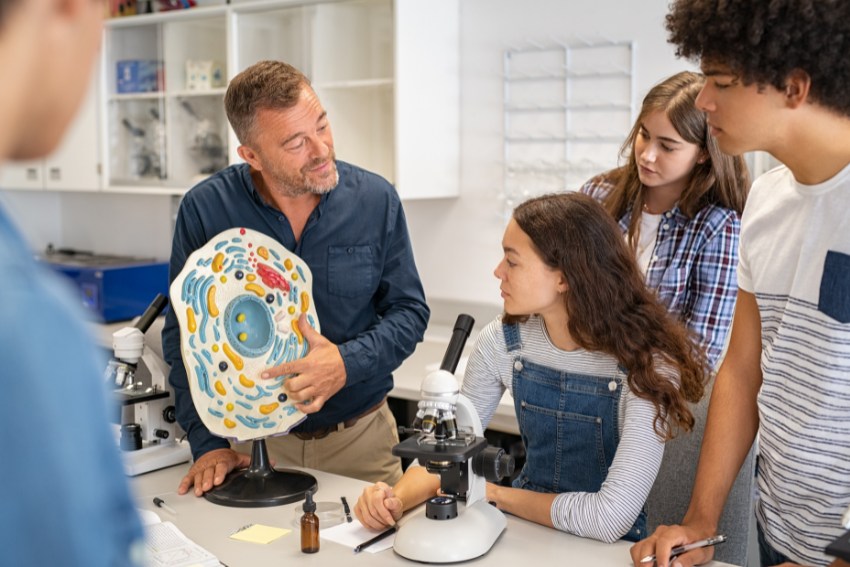Glycolysis A-Level Biology: Everything You Need to Know to Succeed
Let’s dive into glycolysis A-level biology, the energy-making process that keeps your cells buzzing! Think of glycolysis as your body’s way of breaking down glucose to release energy, like turning food into fuel. It happens in the cytoplasm of your cells and, fun fact, it doesn’t even need oxygen to get started.
In A-Level Biology, glycolysis is a must-know topic. It’s the first step in cellular respiration and often pops up in exams, so understanding how it works can seriously boost your grades. Plus, it plays a big role in both aerobic respiration and anaerobic respiration, making it super versatile.
By the end of this guide, you’ll not only understand the steps of glycolysis A-Level Biology but also why it’s so important for keeping cells and you full of energy!
- What is Glycolysis A-Level Biology?
- Describe the Process of Glycolysis A-Level Biology
- The Aerobic Respiration Equation & Glycolysis A-Level Biology
- ATP Production in Glycolysis A-Level Biology
- Anaerobic vs Aerobic Glycolysis A-Level Biology
- Why is Glycolysis Important?
- Real-World Applications of Glycolysis
- Conclusion: Mastering Glycolysis A-Level Biology
What is Glycolysis A-Level Biology?
Glycolysis might sound complex, but it’s actually a simple and essential process that keeps your cells energised. Glycolysis begins cellular respiration by breaking down one glucose molecule to release energy.
This process happens in the cytoplasm of your cells that’s the jelly-like substance where lots of cell activity takes place. The main goal of glycolysis? To convert glucose into something your cells can use for energy, while also producing a bit of energy straight away.
During glycolysis, your cells make molecules of ATP , which is like the energy currency your body runs on. Even though glycolysis doesn’t produce loads of ATP, it’s still super important. It kick-starts the energy-making process and works with or without oxygen. Glycolysis always starts the process, whether your cells are going for a long run or running low on oxygen!
Describe the Process of Glycolysis A-Level Biology
Glycolysis is a 10-step metabolic pathway that breaks down glucose into two molecules of pyruvate, producing ATP and NADH along the way. The process of glycolysis divides into two main phases: the Energy Investment Phase and the Energy Payoff Phase.
Energy Investment Phase
The process begins with the Energy Investment Phase, where the cell uses ATP to prepare glucose for breakdown. First, glucose is phosphorylated by the enzyme hexokinase, using one molecule of ATP, resulting in glucose-6-phosphate (G6P). This modification makes glucose more chemically reactive and traps it inside the cell. Next, G6P is converted into fructose-6-phosphate (F6P) through an isomerisation reaction catalysed by phosphoglucose isomerase. This sets up the molecule for another phosphorylation step.
The enzyme phosphofructokinase then adds another phosphate group to F6P, using another ATP molecule, forming fructose-1,6-bisphosphate. The rate-limiting step of glycolysis tightly regulates the pathway. The F1,6BP molecule splits into two three-carbon sugars: glyceraldehyde-3-phosphate (G3P) and dihydroxyacetone phosphate (DHAP). Only G3P directly continues through glycolysis, but the enzyme triose phosphate isomerase quickly converts DHAP into another G3P molecule, resulting in two G3P molecules ready for the next phase.
Energy Payoff Phase
The Energy Payoff Phase is where the cell generates ATP and NADH. Each G3P molecule undergoes oxidation, facilitated by glyceraldehyde-3-phosphate dehydrogenase, which reduces NAD⁺ to NADH and attaches an inorganic phosphate, forming 1,3-bisphosphoglycerate (1,3-BPG). This high-energy molecule then donates a phosphate group to ADP through the action of phosphoglycerate kinase, producing one ATP and forming 3-phosphoglycerate (3PG).
The 3PG molecule undergoes a structural rearrangement by phosphoglycerate mutase, converting it into 2-phosphoglycerate (2PG). Next, the enzyme enolase removes a water molecule from 2PG, resulting in the highly energetic phosphoenolpyruvate (PEP). Finally, PEP donates its phosphate group to ADP, generating another ATP and forming pyruvate, a reaction catalysed by pyruvate kinase.
Net Products of Glycolysis
By the end of glycolysis, from one glucose molecule, the cell produces a net gain of 2 ATP molecules, 2 NADH molecules, and 2 pyruvate molecules. These products are critical for further energy production. In the presence of oxygen, pyruvate enters the mitochondria for aerobic respiration. Without oxygen, pyruvate undergoes anaerobic fermentation, resulting in products like lactate or ethanol.

The Aerobic Respiration Equation & Glycolysis A-Level Biology
Aerobic respiration is the process cells use to produce energy efficiently by breaking down glucose in the presence of oxygen. The overall chemical equation for aerobic respiration is:
C6H12O6 + 6O2 → 6CO2 + 6H2O + ATP
This equation shows that one molecule of glucose (C₆H₁₂O₆) reacts with six molecules of oxygen (O₂) to produce six molecules of carbon dioxide (CO₂), six molecules of water (H₂O), and a significant amount of ATP, the energy currency of the cell.
How Glycolysis Fits In
Glycolysis is the first step in aerobic respiration and occurs in the cytoplasm. It doesn’t require oxygen, making it an anaerobic process. Here’s what happens during glycolysis:
- One glucose molecule (C₆H₁₂O₆) is broken down into two molecules of pyruvate.
- The process produces a net gain of 2 ATP molecules.
- 2 NADH molecules are generated, which will later be used in the electron transport chain.
From Glycolysis to the Krebs Cycle
When oxygen is available, the pyruvate molecules produced in glycolysis enter the mitochondria for further breakdown in the Krebs cycle. Pyruvate undergoes a transition step before it enters the Krebs cycle, converting into acetyl-CoA, releasing one molecule of CO₂, and generating additional NADH.
In the Krebs cycle:
- Acetyl-CoA is fully oxidised to produce CO₂.
- More NADH and FADH₂ are generated.
- A small amount of ATP is produced directly.
NADH and FADH₂, the high-energy electron carriers, transport electrons to the electron transport chain, where oxidative phosphorylation produces most ATP.
Why Glycolysis Is Important
Glycolysis is essential because it initiates the breakdown of glucose and provides the necessary pyruvate for aerobic respiration. Without glycolysis, the cell wouldn’t be able to enter the highly efficient ATP-generating stages of the Krebs cycle and electron transport chain. Additionally, glycolysis provides intermediates used in other metabolic pathways, making it a vital process in cellular metabolism.
ATP Production in Glycolysis A-Level Biology

Glycolysis is a vital metabolic pathway where cells generate energy in the form of ATP. Here’s how ATP is produced during this process:
- Substrate-Level Phosphorylation: ATP is created directly in glycolysis through substrate-level phosphorylation. This involves transferring a phosphate group from a phosphorylated intermediate to ADP, forming ATP without the need for oxygen or the electron transport chain.
- Energy Investment and Payoff: While the energy investment phase uses 2 ATP molecules to kickstart the breakdown of glucose, the energy payoff phase produces 4 ATP molecules. This results in a net gain of 2 ATP for the cell.
- NADH Formation: Alongside ATP production, glycolysis generates 2 NADH molecules. These high-energy electron carriers play a crucial role in aerobic respiration, transporting electrons to the electron transport chain for further ATP synthesis.
In total, glycolysis efficiently provides energy for cells, even in anaerobic conditions, by producing ATP and NADH from a single glucose molecule.
Anaerobic vs Aerobic Glycolysis A-Level Biology
Glycolysis can proceed through two different pathways depending on the presence or absence of oxygen: aerobic or anaerobic. While both start with the breakdown of glucose into pyruvate, what happens next differs significantly.
In aerobic glycolysis, oxygen is present, allowing pyruvate to enter the mitochondria and continue through the Krebs cycle and the electron transport chain. This process results in a high ATP yield.
In contrast, anaerobic glycolysis occurs when oxygen is scarce or absent. In humans, cells convert pyruvate into lactic acid during lactic acid fermentation. It allows glycolysis to continue by regenerating NAD⁺ but produces significantly less ATP.
Key differences between Aerobic Glycolysis and Anaerobic Glycolysis
| Feature | Aerobic Glycolysis | Anaerobic Glycolysis |
| Oxygen Requirement | Requires oxygen | Occurs without oxygen |
| End Product | Pyruvate (enters Krebs cycle) | Lactic acid (in humans) or ethanol (in yeast) |
| ATP Yield | Net gain of 2 ATP (plus more via Krebs/ETC) | Net gain of 2 ATP (no further ATP production) |
| NADH Fate | NADH enters the electron transport chain | NADH used to convert pyruvate to lactic acid |
| Location | Cytoplasm (glycolysis) and mitochondria (Krebs) | Cytoplasm only |
Why is Glycolysis Important?
Glycolysis is a fundamental process in cellular respiration, making it a key concept in A-Level Biology. It plays a vital role in energy production, ensuring that cells have a constant supply of ATP. Here’s why glycolysis is so important:
- Essential for All Cells: One of the reasons glycolysis is so important is its universality. It occurs in both prokaryotic and eukaryotic cells, highlighting its evolutionary significance. Since glycolysis takes place in the cytoplasm, it doesn’t require complex organelles like mitochondria, making it accessible to all cell types, including simple prokaryotic organisms.
- ATP Production: Glycolysis generates a net gain of 2 ATP molecules, providing essential energy for cells, particularly when oxygen is limited. Additionally, the production of NADH during glycolysis is critical for later stages of respiration in aerobic conditions or for regenerating NAD⁺ during anaerobic respiration.
- Evolutionary Importance: it is one of the oldest metabolic pathways, present in nearly all living organisms. it allows survival in low-oxygen environments by providing an alternative energy source.
Real-World Applications of Glycolysis
Glycolysis isn’t just a topic for A-Level Biology exams, it has real-world significance in medicine, sports, and biotechnology. Understanding how this pathway works can help explain everything from how our bodies power through intense workouts to how industries produce biofuels and alcoholic beverages. Let’s dive into some key applications!
Medical Relevance
Glycolysis plays a crucial role in medical research, especially in understanding diseases like cancer. The Warburg effect, for instance, highlights how cancer cells rely heavily on glycolysis for energy, even in the presence of oxygen. This abnormal metabolic pathway allows cancer cells to grow rapidly, making glycolysis a target for cancer therapies and diagnostic tools like PET scans.
Athletic Performance
Glycolysis is vital for athletic performance, particularly during intense, anaerobic activities like sprinting or weightlifting. When oxygen levels are low, muscles rely on anaerobic glycolysis to quickly generate ATP, providing short bursts of energy. However, this also leads to lactic acid buildup, which causes muscle fatigue during prolonged high-intensity exercise.
Biotechnological Uses
Glycolysis has practical applications in biotechnology, especially in fermentation processes. For example, yeast cells use glycolysis during anaerobic respiration to convert glucose into ethanol and carbon dioxide. This process is essential in industries like brewing, winemaking, and biofuel production, where ethanol serves as the primary product.
Conclusion: Mastering Glycolysis A-Level Biology
Glycolysis A-Level Biology is the first step in breaking down glucose to produce energy, It occurs in the cytoplasm and leads to the formation of ATP, NADH, and pyruvate. Understanding the energy investment and payoff phases, as well as how glycolysis connects to both aerobic and anaerobic respiration, is essential for exam success.
To master glycolysis, practise past paper questions regularly and focus on structuring your answers clearly. Using diagrams can help illustrate your understanding and earn you extra marks. Also, don’t forget to memorise key terms and processes, as they often appear in exam questions.
Need extra help with A-Level Biology? Edumentors offers expert tutoring tailored to your needs. Our online tutors can help you break down complex topics like glycolysis, guide you through exam techniques, and boost your confidence. Get the support you need to ace your exams with Edumentors!
FAQ
What is glycolysis in A-level biology?
Glycolysis A-Level Biology is the first stage of cellular respiration, where glucose breaks down into pyruvate in the cytoplasm, producing ATP and NADH.
How many ATP are produced in glycolysis A-level biology?
In Glycolysis A-Level Biology, a total of 4 ATP molecules are produced, but with 2 used during the process, the net gain is 2 ATP.
Why are 4 ATP produced in glycolysis A-level biology?
Glycolysis A-Level Biology produces 4 ATP through substrate-level phosphorylation during the energy payoff phase, where enzymes directly generate ATP from intermediates.
What is the role of ATP in glycolysis?
In Glycolysis A-Level Biology, ATP provides energy during the energy investment phase to phosphorylate glucose and is later generated as a net energy gain.








